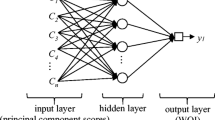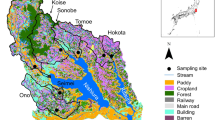Abstract
In this study, an investigation was undertaken to determine whether the predictive accuracy of an indirect, multiwavelength spectroscopic technique for rapidly determining oxygen demand (OD) values is affected by the use of unfiltered and turbid samples, as well as by the use of absorbance values measured below 200 nm. The rapid OD technique was developed that uses UV–Vis spectroscopy and artificial neural networks (ANNs) to indirectly determine chemical oxygen demand (COD) levels. It was found that the most accurate results were obtained when a spectral range of 190–350 nm was provided as data input to the ANN, and when using unfiltered samples below a turbidity range of 150 NTU. This is because high correlations of above 0.90 were obtained with the data using the standard COD method. This indicates that samples can be measured directly without the additional need for preprocessing by filtering. Samples with turbidity values higher than 150 NTU were found to produce poor correlations with the standard COD method, which made them unsuitable for accurate, real-time, on-line monitoring of OD levels.





Similar content being viewed by others
References
APHA (1995) Standard methods for the examination of water and wastewater, 19th edn. APHA-AWWA-WEF, Washington, DC
Domini C, Hidalgo M, Marken F, Canals A (2006) Anal Chim Acta 561:210–217
Cuesta A, Todoli J, Mora J, Canals A (1998) Anal Chim Acta 372:399–409
Cuesta A, Todoli J, Canals A (1996) Spectrochim Acta Part B 51:1791–1800
Hu Z, Chandran K, Smets B, Grasso D (2002) Water Res 36:617–624
Li B, Zhang Z, Wang J, Xu C (2003) Talanta 61:651–658
Zhang S, Jiang D, Zhao H (2006) Environ Sci Technol 40:2363–2368
Li J, Zheng L, Li L, Shi G, Xian Y, Jin L (2006) Electroanal 18:1014–1018
Brookman S (1997) Water Res 32:372–374
Bourgeois W, Burgess J, Stuetz R (2001) J Chem Technol Biot 76:337–348
Charef A, Ghauch A, Baussand P, Martin-Bouyer M (2000) Measurement 28:219–224
Chevalier L, Irwin C, Craddock J (2002) Adv Environ Res 6:369–375
Dobbs R, Wise R, Dean R (1972) Water Res 6:1173–1180
Edwards C, Cresser M (1987) Water Res 21:49–56
Filho H, Galvo R, Araujo M, da Silva E, Saldanha T, Jose G, Pasquini C, Milton R, Rohwedder J (2004) Chemometr Intell Lab 72:83–91
Fogelman S, Blumenstein M, Zhao H (2006) Neural Comput Appl 15:197–203
Khorassani H, Bitar H, Thomas O (1999) Wat Sci Tech 39:77–82
Markva M (1983) Water Res 17:231–235
Markva M (1971) Wasserwirt-Wassertech 21:280–284
Masmoudi R (1999) TAPPI J 82:111–119
Reynolds D, Ahmad S (1997) Water Res 31:2012–2018
Thomas O, Theraulaz F, Agnel C, Suryani S (1996) Environ Technol 17:251–261
Ahmad S, Reynolds D (1999) Water Res 33:2069–2074
Dahlen J, Backstorm M, Hagberg J, Pettersson H (2000) Chemosphere 40:71–77
Rumelhart D, Hinton G, Williams R (1996) Learning internal representations by error propagation, in parallel distributed processing: explorations in the microstructures of cognition. MIT Press, Cambridge, MA
Tarassenko T (1998) A guide to neural computing applications. Wiley, New York
Author information
Authors and Affiliations
Corresponding author
Rights and permissions
About this article
Cite this article
Fogelman, S., Zhao, H. & Blumenstein, M. A rapid analytical method for predicting the oxygen demand of wastewater. Anal Bioanal Chem 386, 1773–1779 (2006). https://doi.org/10.1007/s00216-006-0817-3
Received:
Revised:
Accepted:
Published:
Issue Date:
DOI: https://doi.org/10.1007/s00216-006-0817-3




